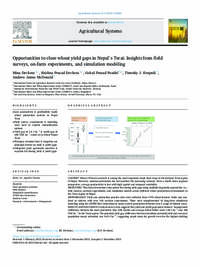Opportunities to close wheat yield gaps in Nepal’s Terai: Insights from field surveys, on-farm experiments, and simulation modeling

Authors:
CONTEXT
Wheat (Triticum aestivum) is among the most important staple food crops in the lowland Terai region of Nepal. However, national production has not matched the increasing demand. From a South Asian regional perspective, average productivity is low with high spatial and temporal variability.
OBJECTIVES
This study determines entry points for closing yield gaps using multiple diagnostic approaches, i.e., field surveys, on-farm experiments, and simulation models across different wheat production environments in the Terai region of Nepal.
METHODOLOGY
Yield and production practice data were collected from 1745 wheat farmers' fields and analysed in tandem with over 100 on-farm experiments. These were complemented by long-term simulation modeling using the APSIM Next Generation to assess system production behavior over a range of climate years.
RESULTS AND DISCUSSION
On-farm survey data suggests that yield and profit gaps under farmers' management (difference between the most productive (top 10th decile) and average wheat fields) were 1.60 t ha−1 and 348 USD ha−1 in the Terai region. The potential yield gap (difference between simulated potential yield and surveyed population mean) estimated was 4.63 t ha−1, suggesting ample room for growth even for the highest-yielding fields. Machine learning diagnostics of survey data, and on-farm trials identified nitrogen rate, irrigation management, terminal heat stress, use of improved varieties, seeding date, seeding method, and seeding rate as the principal agronomic drivers of wheat yield. While fields in the top 10th decile yield distribution had higher fertilizer use efficiencies and irrigation and seeding rates with similar overall production costs as average-yielding farmers. Our results suggest a complementary set of agronomic interventions to increase wheat productivity among lower-yielding farms in the Terai including advancing the time of seeding by 7–10 days on average, increasing nitrogen fertilizer by 20 kg ha−1, and alleviating water stress by applying two additional irrigations.
SIGNIFICANCE
Although wheat yields in the Terai are among the lowest in the region, biophysical production potential is high and remains largely untapped due to sub-optimal agronomic management practices rather than intrinsic agroecological factors. Data from this study suggests that incremental changes in these practices may result in substantial gains in productivity and profitability.
